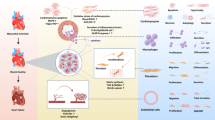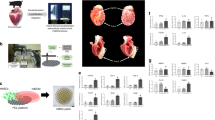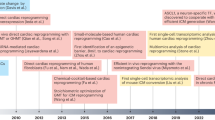Abstract
The possibility that cardiac cell-repair therapy might become a clinical reality is a challenge worthy of the current state of technological and scientific expertise at the start of the 21st century. The success of preclinical and early clinical studies is a strong inducement to move ahead with larger clinical trials, but caution is warranted given our lack of understanding of the potential mechanisms by which cell-repair therapy exerts a benefit on ventricular function, perfusion, and infarct size, irrespective of the type of cell, method, site, and disease entity. There are multiple clinical, mechanistic, and safety questions requiring answers, and these will be forthcoming only if the design of clinical trials is carefully tailored to answer specific questions. These questions, in turn, will require the use of different and multiple end points, depending on the specific issue and study. Accordingly, this review addresses the limitations of current clinical studies, the design of future trials, and the concept of a hierarchical series of end points that might provide answers to a host of different questions. Clinical and basic scientists need to approach the next generation of trials in partnership.
This is a preview of subscription content, access via your institution
Access options
Subscribe to this journal
Receive 12 print issues and online access
$209.00 per year
only $17.42 per issue
Buy this article
- Purchase on Springer Link
- Instant access to full article PDF
Prices may be subject to local taxes which are calculated during checkout



Similar content being viewed by others
References
National Heart, Lung, and Blood Institute (2004) Morbidity and Mortality: 2004 Chartbook on Cardiovascular Lung and Blood Diseases. Bethesda, MD: National Heart, Lung, and Blood Institute
Bardy GH et al. (2005) Amiodarone or an implantable cardioverter-defibrillator for congestive heart failure. N Engl J Med 352: 225–237
Wollert KC and Drexler H (2005) Clinical applications of stem cells for the heart. Circ Res 96: 151–163
Gersh BJ and Caplice NM (2002) Stem cells to repair the heart: a clinical perspective. Circ Res 91: 1092–1102
Caplice NM et al. (2005) Cell therapy for cardiovascular disease: what cells, what diseases, and for whom. Nat Clin Pract Cardiovasc Med 2: 37–43
Gnecchi M et al. (2005) Paracrine action accounts for marked protection of ischemic heart by akt-modified mesenchymal stem cells. Nat Med 11: 367–368
Hodgson DM et al. (2004) Stable benefit of embryonic stem cell therapy in myocardial infarction. Am J Physiol 287: H471–H479
Chien KR (2004) Stem cells: lost in translation. Nature 428: 607–608
Caplice NM and Deb A (2004) Myocardial-cell replacement: the science, the clinic and the future. Nat Clin Pract Cardiovasc Med 1: 90–98
Dai W et al. (2005) Allogeneic mesenchymal stem cell transplantation in postinfarcted rat myocardium: short- and long-term effects. Circulation 112: 214–218
Melo LG et al. (2004) Molecular and cell-based therapies for protection, rescue, and repair of ischemic myocardium: reasons for cautious optimism. Circulation 109: 2386–2393
Makkar RR et al. (2003) Stem cell therapy for myocardial repair: is it arrhythmogenic? J Am Coll Cardiol 42: 2063–2069
Singh SK et al. (2003) Identification of a cancer stem cell in human brain tumors. Cancer Res 63: 5821–5828
Aicher A et al. (2003) Assessment of the tissue distribution of transplanted human endothelial progenitor cells by radioactive labeling. Circulation 107: 2134–2139
Yoon YS et al. (2004) Unexpected severe calcification after transplantation of bone marrow cells in acute myocardial infarction. Circulation 109: 3154–3157
Kang HJ et al. (2004) Effects of intracoronary infusion of peripheral blood stem-cells mobilised with granulocyte-colony stimulating factor on left ventricular systolic function and restenosis after coronary stenting in myocardial infarction: the MAGIC cell randomised clinical trial. Lancet 363: 746–747
Bartunek J et al. (2005) Intracoronary injection of CD133-positive enriched bone marrow progenitor cells promotes cardiac recovery after recent myocardial infarction: feasibility and safety. Circulation 112: I178–I183
Vulliet PR et al. (2004) Intra-coronary arterial injection of mesenchymal stromal cells and microinfarction in dogs. Lancet 363: 783–784
Rauscher FM et al. (2003) Aging, progenitor cell exhaustion, and atherosclerosis. Circulation 108: 457–463
Tepper OM et al. (2002) Human endothelial progenitor cells from type II diabetics exhibit impaired proliferation, adhesion, and incorporation into vascular structures. Circulation 106: 2781–2786
Fleming TR and DeMets DL (1996) Surrogate end points in clinical trials: are we being misled? Ann Int Med 125: 605–613
Burkhoff D et al. (2001) Variability of myocardial perfusion defects assessed by thallium-201 scintigraphy in patients with coronary artery disease not amenable to angioplasty or bypass surgery. J Am Coll Cardiol 38: 1033–1039
Pislaru SV and Simari RD (2005) Gene transfer for ischemic cardiovascular disease: is this the end of the beginning or the beginning of the end? Nat Clin Pract Cardiovasc Med 2: 138–144
Author information
Authors and Affiliations
Corresponding author
Ethics declarations
Competing interests
The authors declare no competing financial interests.
Rights and permissions
About this article
Cite this article
Gersh, B., Simari, R. Cardiac cell-repair therapy: clinical issues. Nat Rev Cardiol 3 (Suppl 1), S105–S109 (2006). https://doi.org/10.1038/ncpcardio0400
Received:
Accepted:
Issue Date:
DOI: https://doi.org/10.1038/ncpcardio0400
This article is cited by
-
Advances in Molecular Imaging: Cardiac Regeneration
Current Cardiovascular Imaging Reports (2013)
-
The Paracrine Effect: Pivotal Mechanism in Cell-Based Cardiac Repair
Journal of Cardiovascular Translational Research (2010)



